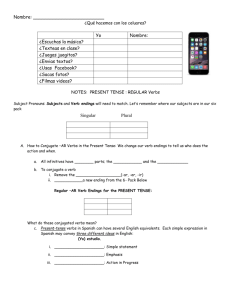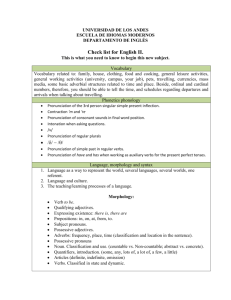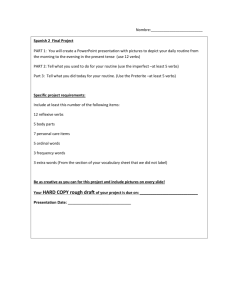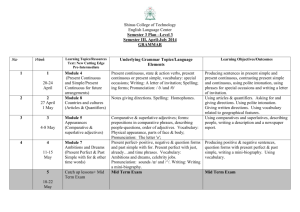Pronunciation Lesson Plan
advertisement
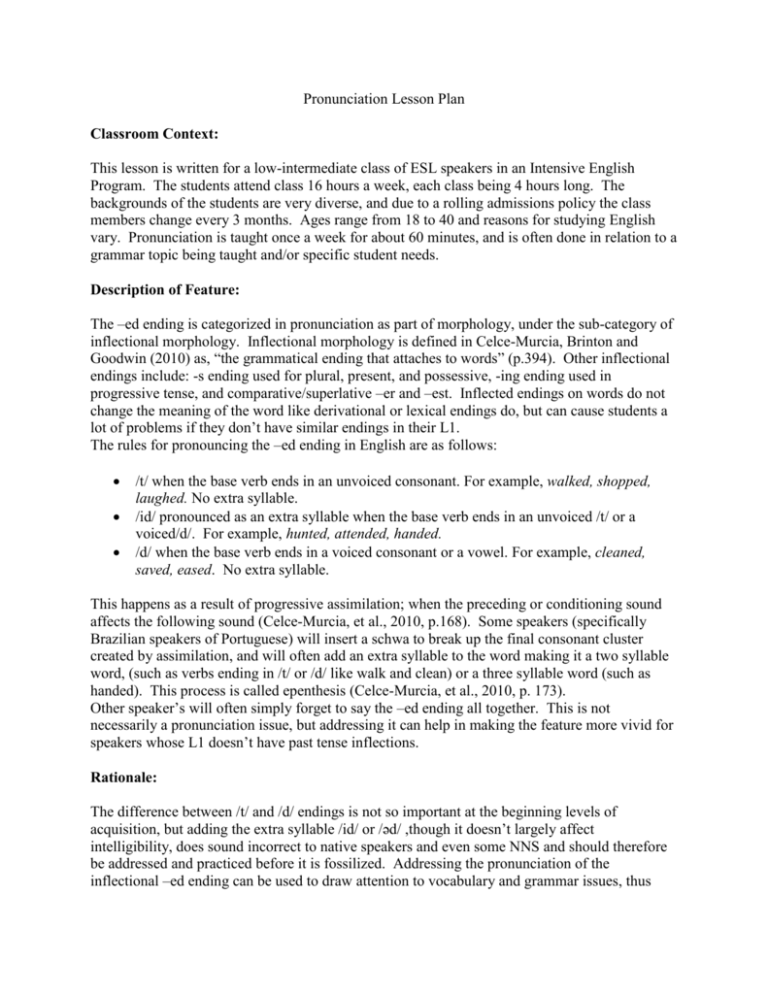
Pronunciation Lesson Plan Classroom Context: This lesson is written for a low-intermediate class of ESL speakers in an Intensive English Program. The students attend class 16 hours a week, each class being 4 hours long. The backgrounds of the students are very diverse, and due to a rolling admissions policy the class members change every 3 months. Ages range from 18 to 40 and reasons for studying English vary. Pronunciation is taught once a week for about 60 minutes, and is often done in relation to a grammar topic being taught and/or specific student needs. Description of Feature: The –ed ending is categorized in pronunciation as part of morphology, under the sub-category of inflectional morphology. Inflectional morphology is defined in Celce-Murcia, Brinton and Goodwin (2010) as, “the grammatical ending that attaches to words” (p.394). Other inflectional endings include: -s ending used for plural, present, and possessive, -ing ending used in progressive tense, and comparative/superlative –er and –est. Inflected endings on words do not change the meaning of the word like derivational or lexical endings do, but can cause students a lot of problems if they don’t have similar endings in their L1. The rules for pronouncing the –ed ending in English are as follows: /t/ when the base verb ends in an unvoiced consonant. For example, walked, shopped, laughed. No extra syllable. /id/ pronounced as an extra syllable when the base verb ends in an unvoiced /t/ or a voiced/d/. For example, hunted, attended, handed. /d/ when the base verb ends in a voiced consonant or a vowel. For example, cleaned, saved, eased. No extra syllable. This happens as a result of progressive assimilation; when the preceding or conditioning sound affects the following sound (Celce-Murcia, et al., 2010, p.168). Some speakers (specifically Brazilian speakers of Portuguese) will insert a schwa to break up the final consonant cluster created by assimilation, and will often add an extra syllable to the word making it a two syllable word, (such as verbs ending in /t/ or /d/ like walk and clean) or a three syllable word (such as handed). This process is called epenthesis (Celce-Murcia, et al., 2010, p. 173). Other speaker’s will often simply forget to say the –ed ending all together. This is not necessarily a pronunciation issue, but addressing it can help in making the feature more vivid for speakers whose L1 doesn’t have past tense inflections. Rationale: The difference between /t/ and /d/ endings is not so important at the beginning levels of acquisition, but adding the extra syllable /id/ or /ǝd/ ,though it doesn’t largely affect intelligibility, does sound incorrect to native speakers and even some NNS and should therefore be addressed and practiced before it is fossilized. Addressing the pronunciation of the inflectional –ed ending can be used to draw attention to vocabulary and grammar issues, thus 2 creating the opportunity to use pronunciation in relation to specific grammar points such as simple past and other past tense verbs which will be used throughout this lesson. The lesson begins with a very brief discussion of the weekend. As mentioned, this lesson takes place after a review of the simple past, so the lesson lends itself to more speaking practice, as well as the introduction of new past tense vocabulary and forms. Most Ss have most likely had some experience with voiced/unvoiced sounds. This lesson would also be done after covering simple present and S/V agreement, so the Ss would have practiced the final –s inflection by now. Since Ss are at a level where they are beginning to be a little more independent and confident in their language skills, I wanted to create interest in the lesson by allowing Ss the opportunity during the beginning stages of the lesson to discover the rules on their own. I see this as working to promote autonomy and increase confidence and motivation. A brief review of the rules and practice noticing the features of voiced/unvoiced phonemes follows. Ss get some practice saying the words and noticing the differences in pronunciation as written on the board and with me as a model. From here we move to a listening task meant to draw attention to incorrect usage of the past tense. Ss should be able to hear the incorrect pronunciation and notice where it has been deleted altogether. After these activities Ss should be ready to practice using their own short sentences. The controlled memory activity allows them the chance to think about their own word and use it in a sentence, bust they also have to practicing listening to each other. From here, they can work together to produce more thoughtful conversation. Finally, they should be prepared to write their own dialogues and be creative with the language, while hopefully being more aware of their pronunciation of the –ed ending. Goals: To enhance the study of past tense grammar lessons. To draw attention to the three different pronunciations of the –ed ending. To correct any errors in production. Objectives: Ss will be able to recognize and produce the three –ed inflectional endings correctly to the best of their ability. Ss will be able to monitor and correct their own mistakes in pronouncing the endings. Ss will be able to use the correct pronunciation in daily conversation. Ss will become aware of the links between grammar and pronunciation. 3 Time Procedure 10 min. Warm-up: class brainstorm What did you do last weekend? Purpose: To elicit past tense verbs and draw attention to the -ed ending. To review simple past verbs. Activity/Procedure: Give Ss a few minutes to discuss the question in small groups. As a class ask individual Ss what they did last weekend. As each S answers write the base verb under the correct column according to the –ed ending rule. When there are a few verbs in each category (T can add one or two if necessary so there are enough words in each column for Ss to see the difference). Transition: What differences do you notice in these 3 columns? Think about pronunciation and the individual sounds we’ve practiced in the past. (This transitions directly into a description and analysis of the –ed ending rules) Materials and Board Work What did you do last weekend? 3 unlabeled columns drawn on board (only the T will know that each column represents a specific -ed ending sound) *see list of recommended verbs 4 10 min. Description and Analysis: class review of voiced/unvoiced sounds and –ed endings. Purpose: To try to have Ss recognize the 3 different -ed ending pronunciations on their own. To review voiced/unvoiced phonemes /t/ and /d/. Activity/Procedure: Try to elicit the rules from the Ss If Ss are able to determine the rules great; if not help them out by doing the voiced /unvoiced exercise below finally write the rule above each column Ask Ss to add a few words to each category. Review /t/ and /d/ voiced and unvoiced stops. Have Ss place their fingers on their throats an d read the words in the respective columns chorally, alternating between the /t/ and /d/ lists. Next move to the /id/ column and have the students say these words. Transition: Now that you understand the differences in pronunciation I want you to practice listening for errors in a short passage. /t/ sound when based verb ends with unvoiced consonant /d/ sound when base verb ends with voiced consonant or vowel /id/ extra syllable when base verb ends in unvoiced /t/ or voiced /d/ 5 15 min. Listening Discrimination: Listen for errors and mark past tense verbs with appropriate sound. Purpose: To be able to recognize when a word is missing the inflectional past tense ending. To be able to recognize when an –ed ending is mispronounced. Activity Procedure: Have Ss number their papers 1-5. T reads the passage and makes mistakes in the pronunciation. Ss write down the mistakes they hear. Hand the passage to the Ss. Discuss the errors they heard in pairs. T reads the passage again, this time the Ss write the letter of the end sound above each word. Ss read the passage to each other in pairs (switching at paragraphs) and listen for errors. Have one pair demonstrate and read aloud to the class. Transition: We’ve had some practice both speaking and listening for errors. Now I want to practice both of these skills combined. Prepared reading worksheet 6 10 min. Controlled Practice: Memory game What did you do last week? Purpose: To practice both production and listening skills of the –ed ending. Activity Procedure: Divide Ss into 2 groups (there should be no less than 8 in a group). Hand each S an index card with a base verb written on it. S will then think of a sentence using that verb in the past tense responding to the question. Ss get in a circle and T will explain that Ss should hold their cards up so others can see them. When it is their turn they must say their sentence and repeat all of the sentences before theirs. Ss will monitor each other but T will also circulate to listen for correct usage. When finished have Ss exchange cards and reverse the direction of the circle for further practice. Transition: Great job! Now let’s try using some new verbs in casual conversation with each other. By now you should be able to catch your mistakes if you make any, but you’ll again be listening to each other to be sure that your group members are all pronouncing the endings correctly. Don’t be afraid to correct each other! Prepared index cards: call, text, watch, listen, cook, walk, wait, carry, remember, agree 7 10 min. Guided Practice: Answer prepared questions in groups using specific verbs. Purpose: To use past tense verbs in a less controlled, more communicative context. To begin to use the various forms naturally, without thinking about the pronunciation. To be able to hear errors in others speech. Activity Procedure: Hand a list of questions to each S. Have them work in groups of 3-4 They will take turns reading the questions and each S in the group will answer the question. Ss must use the underlined verb in their answer. T will listen to Ss production making sure of correct usage. Follow up by having Ss report on someone in their group until each verb had been used. Transition: Alright, you’ve had a lot of practice and maybe you’ve learned a few new verbs, so now you’re going to write your own conversation with a partner or in groups of three. 10 min. Communicative Practice: Write a dialogue using each –ed ending pronunciation. Purpose: To practice using various verbs with –ed endings in a variety of communicative settings. To fine tune pronunciation skills To use language in Ss own creative way Activity Procedure: Ss will be instructed to use whatever verbs they want and create a dialogue. List of questions/prompts 8 The only rule is they must use each of the endings at least once. They should be encouraged to try to use as many as possible while still making a dialogue that can be understood. T will walk around the room to help, answer any questions, and be sure Ss are on task. Transition: Ok everyone, it’s about time to go. Please make sure you all have a copy of the dialogue and/or are ready to present it to the class tomorrow morning. Let’s do a quick review of what we learned before we go. 5 min. Review/wrap-up: State the rule for each word and say it. Purpose: To remind Ss of the rules and the purpose of the lesson. words on board: Activity Procedure: point to laughed ask Ss to say the word annunciating the final sound ask them why repeat with each word Closing: I’m exhausted….see you all tomorrow! laughed, attended, saved 9 Possible words for warm-up/description /t/ relax watch cook walk /d/ clean study stay play /id/ decide want start visit Reading for Listening activity *this is also the key Read and have Ss listen for (5) errors (leave off –ed marker and pronounce –ed ending) blue= leave off –ed ending red= pronounce with extra syllable Then read again and have them write the correct sound above the words. Finally have them read to each other and make sure to pronounce correctly. Yesterday was so busy! At the office, I worked hard with my team. We developed a new advertising plan. Our meeting lasted about two hours. I remembered an advertising plan that worked five years ago, and I suggested we try that again. We needed to get the manager's approval. We called him on the office phone. He admitted that the idea seemed good, but he believed we should lower the budget. We reported our numbers to him and talked about the budget for a long time. Finally, he decided to give us the money we wanted. On the way home, I stopped at a discount electronics store. I had promised my daughter a new iPod for her birthday. At the store, I played songs and tested a few different models. I decided to buy a used one at a discounted price. When I got home, the kitchen was a mess. At our house, we have agreed to clean up after ourselves, so I asked around to find out who had cooked last. That person turned out to be my son. While he washed the dishes, I sat at the kitchen table and talked to him about his schoolwork. Last year, he tested into an advanced program, and I wanted to see how he was doing. He seemed happy with it. He started telling me about his classes and what he learned that day. Source: adapted from http://www.speakmethod.com/esl_advanced_ed_pronunciation.html 10 Prompts for group Guided Practice activity example: 1. What is a question you asked someone recently? I asked my friend in NY if I could stay at her place next month. 2. Describe something you explained. 3. Name something you listened to recently. 4. Name something you decided last week. 5. What is a promise you made? 6. Describe how long an event lasted. 7. When is the last time you washed your hands or clothes? 8. Where have you traveled? 9. Name something you started recently. 10. Describe how a friend or relative seemed recently. 11. Write your own! Source: adapted from http://www.speakmethod.com/esl_advanced_ed_pronunciation.html References: Celce-Murcia, M., Brinton, D. M., & Goodwin, J. M. (2010). Teaching pronunciation hardback with audio cds (2): a course book and reference guide. Cambridge University Press.
